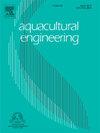Testing of a passive foam fractionator prototype in a commercial recirculating trout farm
IF 3.6
2区 农林科学
Q2 AGRICULTURAL ENGINEERING
引用次数: 0
Abstract
Foam fractionation has emerged as a technical solution to reduce the build-up of microparticles and dissolved organic matter in recirculating aquaculture systems (RAS). However, commercial application in freshwater RAS is challenging and expensive. In the present study, a simple, low-cost passive foam fractionation (PFF) prototype was developed and tested under commercial conditions. The prototype was tested in a Model Trout Farm (MTF) in three different production raceways during winter and spring to assess the operation and removal potential. A number of different water quality parameters, including organic matter, particles, bacterial activity, and phosphorus were examined in the system water and in the removed foamate. Overall, the PFF prototype removed particles as well as particulate and dissolved organic matter, reduced the amount of bacteria and total phosphorus in the water, regardless of sampling time and place. By utilizing the existing airlifts in the MTF, the associated cost of construction and operation was kept low. Overall, the results demonstrate that the passive foam fractionation has the potential to help address some of aquaculture’s pressing issues in a cost effective manner.
在商业循环鳟鱼养殖场进行被动泡沫分馏机样机的测试
泡沫分馏已成为减少循环水养殖系统(RAS)中微粒和溶解有机物积聚的技术解决方案。然而,在淡水RAS中的商业应用是具有挑战性和昂贵的。在本研究中,开发了一种简单、低成本的被动泡沫分馏(PFF)原型,并在商业条件下进行了测试。在冬季和春季,在模型鳟鱼养殖场(MTF)的三个不同的生产跑道中对原型进行了测试,以评估操作和清除潜力。在系统水和去除的甲酸酯中检测了许多不同的水质参数,包括有机物、颗粒、细菌活性和磷。总体而言,无论采样时间和地点如何,PFF原型都可以去除颗粒以及颗粒和溶解的有机物,减少水中的细菌数量和总磷。通过利用MTF现有的空运,相关的建造和运营成本保持在较低水平。总体而言,结果表明,被动泡沫分馏有可能以经济有效的方式帮助解决水产养殖的一些紧迫问题。
本文章由计算机程序翻译,如有差异,请以英文原文为准。
求助全文
约1分钟内获得全文
求助全文
来源期刊

Aquacultural Engineering
农林科学-农业工程
CiteScore
8.60
自引率
10.00%
发文量
63
审稿时长
>24 weeks
期刊介绍:
Aquacultural Engineering is concerned with the design and development of effective aquacultural systems for marine and freshwater facilities. The journal aims to apply the knowledge gained from basic research which potentially can be translated into commercial operations.
Problems of scale-up and application of research data involve many parameters, both physical and biological, making it difficult to anticipate the interaction between the unit processes and the cultured animals. Aquacultural Engineering aims to develop this bioengineering interface for aquaculture and welcomes contributions in the following areas:
– Engineering and design of aquaculture facilities
– Engineering-based research studies
– Construction experience and techniques
– In-service experience, commissioning, operation
– Materials selection and their uses
– Quantification of biological data and constraints
 求助内容:
求助内容: 应助结果提醒方式:
应助结果提醒方式:


